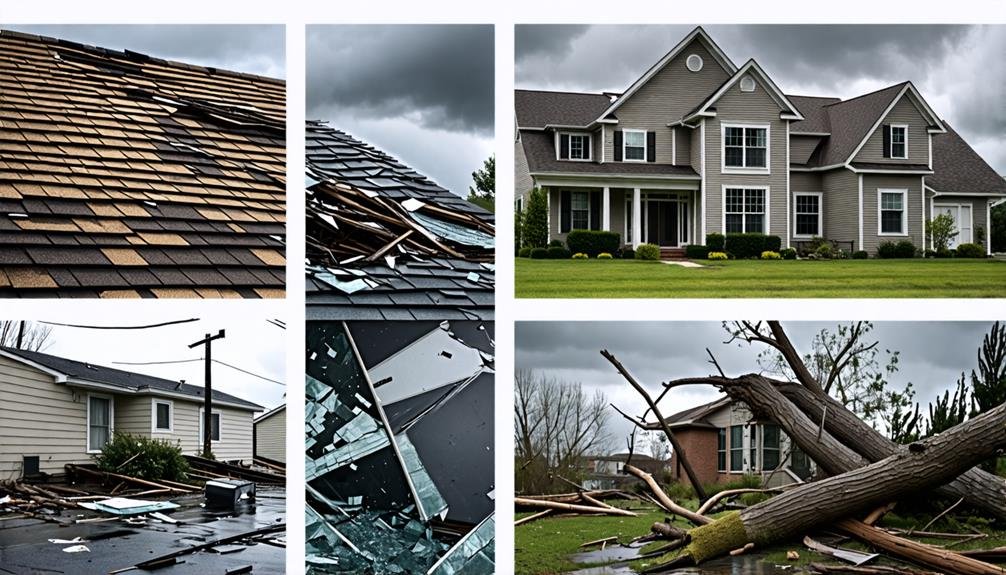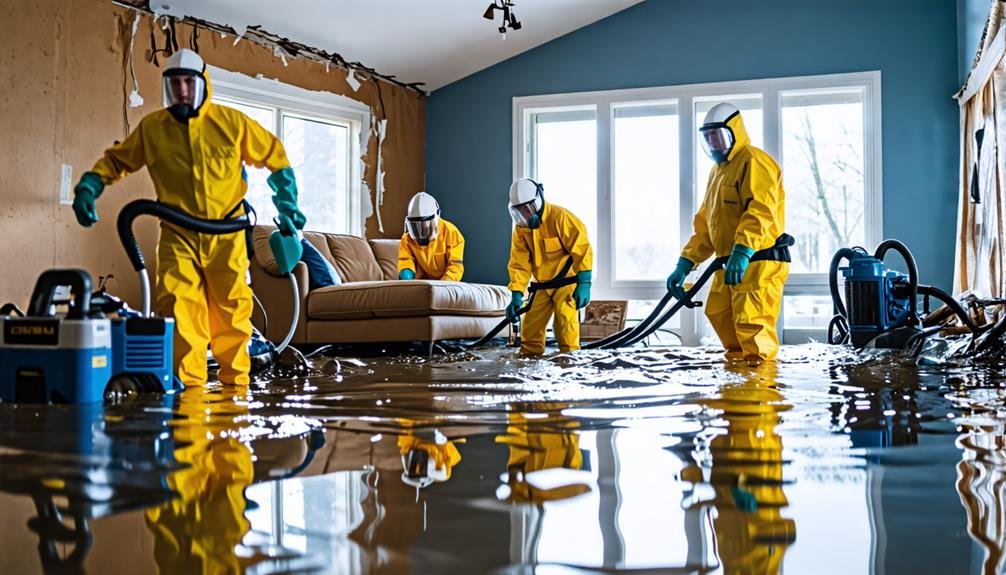When storms strike Atlanta, you need swift and thorough repair solutions to safeguard your home. Start by evaluating damage, such as roof leaks, hail dents, and water stains. Emergency repair services are essential; securing windows and tarping roofs can prevent further issues. Don't underestimate water damage restoration; prompt action can save time and money. Investigate roof repair or replacement options, and take into account structural assessments for foundation stability. Maneuvering the insurance claims process is imperative, so document everything meticulously to guarantee a smooth recovery. There's much more to reflect on as you prepare for future storms and protect your investment.
Types of Storm Damage

When storms hit Atlanta, they can cause various types of damage, ranging from roof leaks and broken windows to flooding and downed power lines, each requiring prompt and careful attention. You might find yourself facing wind damage, where powerful gusts can rip shingles off your roof or snap branches that crash onto your property. This kind of damage can leave your home vulnerable to further issues, so addressing it quickly is vital.
Hail damage is another significant concern during storms. Hailstones can pummel your roof, leading to cracks and punctures that compromise its integrity. You may notice dents on your siding or car, too; these seemingly minor issues could escalate if left unchecked. Broken windows from hail can likewise invite rainwater in, leading to mold and structural problems.
In the wake of a storm, it's fundamental to stay vigilant and assess your property for these types of damage. By understanding the threats posed by wind and hail, you can take action to protect your home and maintain your freedom from worry, ensuring a safe and secure living environment for you and your loved ones.
Assessing Property Damage
After a storm, it's crucial to carefully inspect your property for any signs of damage, as even minor issues can lead to more significant problems if not addressed promptly. Begin your storm assessment by checking the exterior. Look for missing shingles, cracks in the siding, or debris that may have caused damage. Don't forget to inspect windows and doors; broken seals or shattered glass can leave your home vulnerable.
Next, evaluate your landscaping. Downed trees or uprooted plants can pose risks to your home's structure. If you notice any damage, document it with photos to support your insurance claims later.
Inside, check for water stains on ceilings and walls, which could indicate roof leaks. Examine your basement or crawl space for signs of flooding or mold growth. It's crucial to conduct a thorough property evaluation so you can catch potential issues before they escalate.
Emergency Repair Services

Once you've assessed the damage to your property, it's time to contemplate emergency repair services to address urgent issues and prevent further complications. In the aftermath of a storm, securing your home should be your top priority. Quick action can minimize additional damage, particularly from water leaks or structural vulnerabilities.
Emergency repair services specialize in storm response, offering immediate solutions tailored to your needs. They can help board up broken windows, tarp damaged roofs, and clear debris, allowing you to regain a sense of safety and control. These professionals are trained to handle various situations, ensuring your home is protected against further risks.
While you may have some level of emergency preparedness in place, relying on experienced contractors can provide peace of mind. They understand the nuances of storm damage and can guide you through the repair process, keeping you informed every step of the way.
Don't wait for the next storm to hit—take proactive measures today. By engaging emergency repair services, you're not just fixing your home; you're investing in your freedom to feel secure and comfortable within your space again.
Roof Repair and Replacement
Severe storm damage can leave your roof vulnerable, making timely roof repair or replacement crucial to preventing leaks and further structural issues. Understanding your options can empower you to make the best decision for your home.
Consider this roofing materials comparison to help you choose the right solution:
| Material | Lifespan | Maintenance Tips |
|---|---|---|
| Asphalt Shingles | 15-30 years | Regular inspections; clean gutters |
| Metal Roofing | 40-70 years | Check for rust; seal seams |
| Tile Roofing | 50+ years | Monitor for broken tiles; verify proper drainage |
| Wood Shakes | 30 years | Keep clear of debris; treat for pests |
When evaluating your roof, look for visible damage, such as missing shingles or leaks. If repairs are extensive, a replacement might be more cost-effective in the long run. Always consult with a professional to get an accurate evaluation and verify that your new roof meets local codes and standards. With the right roof repair or replacement, you can reclaim your home's security and comfort. Remember, proactive roof maintenance tips can extend your roof's lifespan and save you money in the future.
Water Damage Restoration

When water damage strikes, it's essential to assess the situation quickly to understand the extent of the impact. You'll want to focus on effective mitigation and cleanup techniques to prevent further issues, while additionally considering long-term prevention strategies to safeguard your home in the future. Let's investigate how you can navigate this process with confidence and care.
Assessment and Inspection Process
A thorough assessment and inspection process is critical for identifying the extent of water damage in your property, guaranteeing that all hidden issues are addressed effectively. You'll want to begin with a pre-inspection checklist that helps you gather significant information about the affected areas. This step not only prepares you for the inspection but likewise gives you peace of mind.
During the inspection, professionals will use advanced damage assessment tools, like moisture meters and thermal imaging cameras, to detect hidden moisture and structural damage. They'll assess walls, ceilings, and floors, checking for signs of mold or deterioration that often go unnoticed. It's imperative to be involved in this process, as your insights can help identify areas of concern you may have noticed.
Once the assessment is complete, you'll receive a detailed report outlining the findings and recommended next steps. This transparency guarantees you're informed and empowered to make decisions about the restoration process. Remember, addressing water damage promptly can save you time and money, so don't hesitate to take action. Your home deserves the best care possible, and a thorough assessment is the first step toward restoration.
Mitigation and Cleanup Techniques
Effective mitigation and cleanup techniques are vital to minimizing water damage and guaranteeing your property is restored to its original condition as quickly as possible. When dealing with water damage, it's important to act promptly to prevent further issues, such as mold growth. Start by evaluating the extent of the damage and gather your storm preparedness tools.
Here's a quick reference table for effective mitigation and cleanup techniques:
| Technique | Description | Tools Needed |
|---|---|---|
| Water Extraction | Remove standing water efficiently | Wet/dry vacuum, pumps |
| Drying | Thoroughly dry affected areas | Fans, dehumidifiers |
| Debris Management | Clear out damaged materials | Trash bags, gloves |
Keep in mind that proper debris management not only helps in cleanup but furthermore prepares your space for repairs. Always wear protective gear during the process to guarantee your safety. By following these steps, you're not just restoring your home; you're reclaiming your freedom from the chaos that storms can bring. Don't hesitate to reach out for professional assistance if needed; you're not alone in this journey.
Long-term Prevention Strategies
Implementing long-term prevention strategies is vital for safeguarding your home against future water damage and ensuring peace of mind after a storm. You can start by adopting effective stormproofing techniques that reinforce your home's defenses. Installing flood barriers and sump pumps can redirect excess water away from your foundation, markedly reducing the risk of flooding.
Don't forget about yard considerations, as your yard plays an important role in managing water flow. Grade your yard away from your home to prevent water pooling near your foundation. Moreover, consider planting native vegetation that can absorb excess moisture and improve drainage.
Regular maintenance is key, too. Inspect your gutters and downspouts frequently, ensuring they're clear of debris and directing water away from your home. Sealing cracks in your foundation helps to keep moisture from seeping in.
Structural Repair Solutions
Repairing structural damage after a storm requires a thorough assessment to identify issues like compromised foundations, weakened walls, or roof failures, guaranteeing your home's safety and integrity. You'll want to start by examining your foundation. If it's been undermined, foundation reinforcement techniques—like adding piers or underpinning—can restore stability and prevent future issues.
Next, focus on your load bearing walls. These walls are vital for your home's structural integrity, so any signs of bowing or cracking must be addressed immediately. Reinforcing these walls with steel braces or additional framing can effectively support your home's weight and resist future storm impacts.
Don't overlook the roof; any sagging or leaks could signal severe damage. A professional contractor can help you assess whether repairs or a full replacement is necessary.
It's crucial to act quickly to minimize damage and guarantee your home remains a safe haven. You deserve to feel secure in your space, knowing you've taken the right steps to restore your home. Trust in the expertise of professionals to guide you through this process and reclaim your peace of mind after the storm.
Insurance Claims Process

Steering through the insurance claims process after storm damage can feel overwhelming, but understanding your coverage is the first step towards recovery. You'll need to carefully document the damage to guarantee your claim reflects the full extent of your losses. Once you're ready, filing your claim promptly can make a significant difference in how quickly you receive the support you need.
Understanding Your Coverage
Understanding your insurance coverage is vital for effectively managing the claims process after storm damage, as it determines what repairs are covered and how quickly you can start rebuilding your home. You'll want to familiarize yourself with the different coverage types outlined in your policy, such as dwelling coverage, personal property coverage, and additional living expenses. Each type plays a significant role in guaranteeing you're protected against various storm-related damages.
Be aware of policy limitations that might affect your claim. These can include deductibles, caps on coverage amounts, or exclusions for specific types of damage. Knowing these details can empower you to make educated choices when it comes time to file a claim.
When you understand your coverage, you can approach your insurance provider with confidence, ready to advocate for your needs. This knowledge not only helps you navigate the claims process more smoothly but likewise gives you the freedom to focus on rebuilding your life rather than getting bogged down in confusion over your policy. Be proactive—review your coverage annually to confirm it aligns with your evolving needs and the risks posed by severe weather in Atlanta.
Documenting the Damage
After a storm, promptly documenting the damage to your property is vital for ensuring a smooth insurance claims process and maximizing your potential compensation. Start by walking through your home and yard, looking for any signs of damage. Take detailed notes about what you see, including the date and time of the storm, as this information can be important later.
Next, focus on collecting photographic evidence. Use your smartphone or camera to capture clear images of all affected areas, including roofs, windows, and exterior structures. Make sure to take wide shots to provide context, as well as close-ups that highlight specific damage. If possible, record videos to give a more thorough view of the impact.
Don't forget to document any personal property that was damaged, as this can additionally be included in your claim. As you gather this damage documentation, keep everything organized and consider creating a folder to store all the evidence. This proactive approach not only aids in your claim but also empowers you to take control during a challenging time, ensuring you're well-prepared for the next steps ahead.
Filing Your Claim
Filing your insurance claim promptly can greatly streamline the process of getting the repairs you need after a storm. Start by contacting your insurance company as soon as you've documented the damage. They'll guide you through the claim timeline, which typically involves an adjuster evaluating the damage and determining the coverage.
Be prepared to provide all necessary documentation, including photos, repair estimates, and any relevant receipts. This will help speed up your claim and strengthen your position during claim negotiation. Remember, insurance companies often have specific time frames and protocols to follow, so staying proactive is key.
During negotiations, don't hesitate to advocate for your needs. If the initial offer seems insufficient, present your documented evidence and express your concerns clearly. It's your right to seek a fair resolution, and most insurers appreciate collaboration over confrontation.
Lastly, keep a record of all communications with your insurer, as this can be invaluable if any discrepancies arise. By taking these steps, you'll not only expedite your claim but likewise regain your peace of mind, allowing you to focus on rebuilding and moving forward.
Preventive Measures for Future Storms
Implementing strategic preventive measures can greatly reduce the risk of storm damage to your property, ensuring you're better prepared for whatever Mother Nature throws your way. Start by reviewing your home maintenance strategies. Regularly inspect your roof, siding, and windows for any wear and tear. Addressing small issues now can save you from significant damage later.
Consider investing in storm shutters or reinforced doors to protect against high winds. In addition, clear gutters and downspouts regularly to prevent water backup, which can lead to leaks and flooding. These storm preparedness tips not only fortify your home but also provide peace of mind.
Don't forget your yard—trim trees and remove dead branches that could become projectiles during a storm. If you live in a flood-prone area, consider installing sump pumps or flood barriers.
Conclusion
In the face of Mother Nature's whims, your home deserves the best care. By understanding the types of storm damage and knowing how to navigate repairs, you're not just fixing a roof or drying out walls; you're nurturing your sanctuary. Welcome proactive measures to shield your haven from future tempests. With the right support, you can turn those challenges into opportunities for renewal. Remember, every storm passes, and brighter days await just around the corner.

